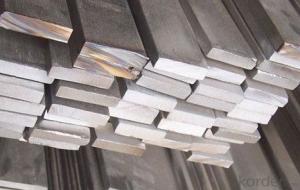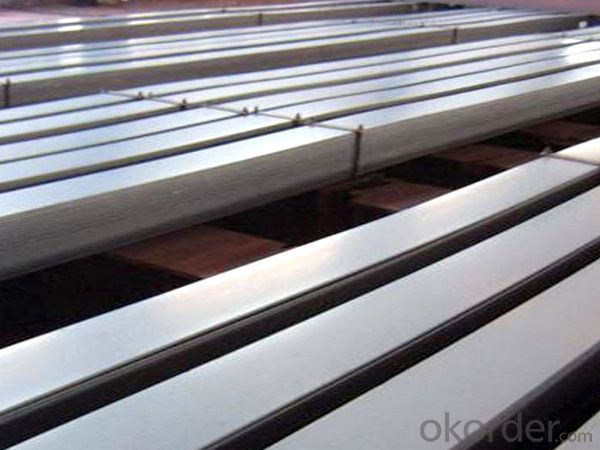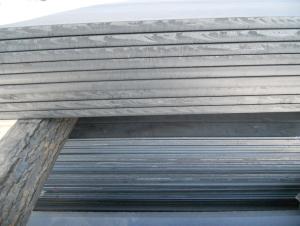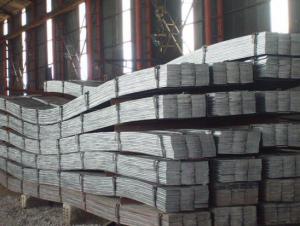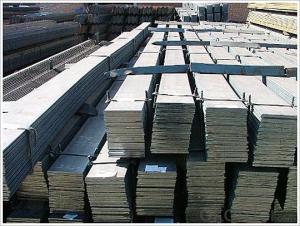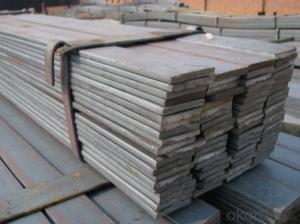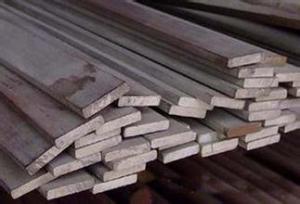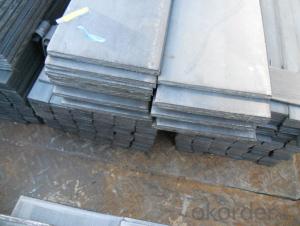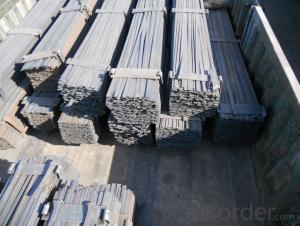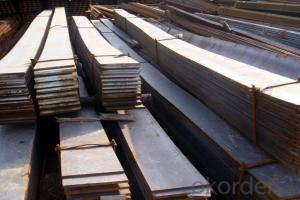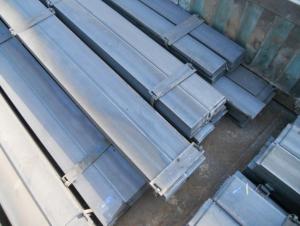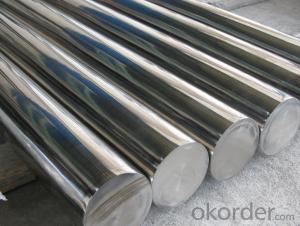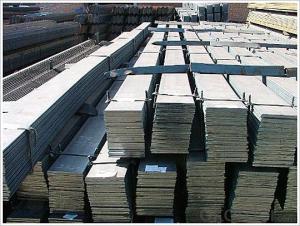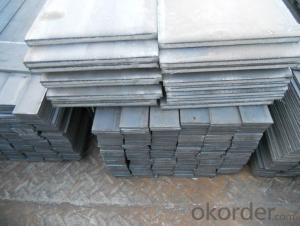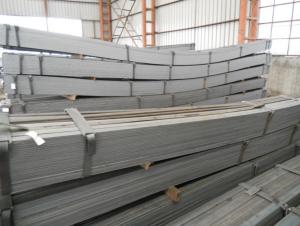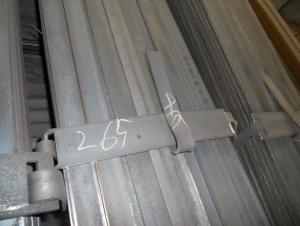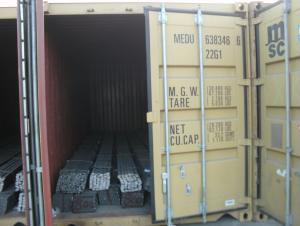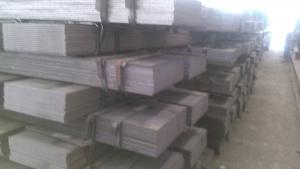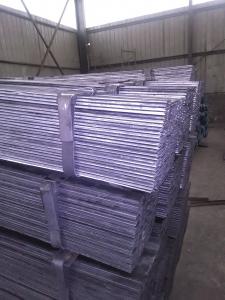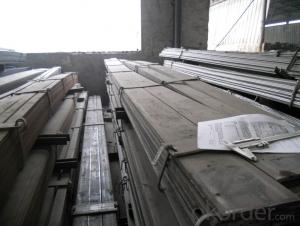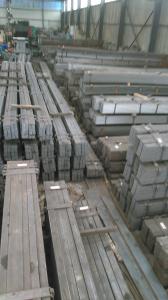Good Quality Special Steel Flat Bar For Automobile Used
- Loading Port:
- Shanghai
- Payment Terms:
- TT OR LC
- Min Order Qty:
- 50 m.t.
- Supply Capability:
- 1000 m.t./month
OKorder Service Pledge
OKorder Financial Service
You Might Also Like
Commodity: Carbon Steel Flat Bar For Car
Standard: GB, JIS, ASTM,
Material: Q235, SS400 or Equivalent
Origin place: China
Thickness: 3mm-30mm
Width:20mm-200mm
Length: Max 12m
Certification: SGS/BV
Chemical composition
Alloy No | Grade | Element(%) | ||||
C | Mn | S | P | Si | ||
Q235 | B | 0.12—0.20 | 0.3—0.7 | ≤0.045 | ≤0.045 | ≤0.3 |
Physical properties
Alloy No | Grade | Yielding strength point(Mpa) | Tensile strength (Mpa) | Elongation after fracture(%) | ||||||
Thickness (mm) | Thickness (mm) | |||||||||
≤16 | >16--40 | >40--60 | >60--100 | ≤16 | >16--40 | >40--60 | >60--100 | |||
≥ | ≥ | |||||||||
Q235 | B | 235 | 225 | 215 | 205 | 375--500 | 26 | 25 | 24 | 23 |
Usage/Applications of Flat Bar
Widely used for construction;
Machinery manufacturing;
Iron tower steel structure;
Shipbuilding; Steel grating;
Staircase;
Bridge;
Viaduct;
Railway spare parts;
Boilers making etc.
Packaging & Delivery
Packaging Details: The Steel Flat Bars are packed in bundles and loaded in 20 feet/40 feet container, or shipped by bulk cargo ,also we can do as customer's requirements.
Delivery Details:30~45 days upon the receipt of buyer payment by T.T. or L/C.
Production Flow
The Carbon Steel Flat Bar is made through three processes:
1.Feeding the material: Feeding the row material (the steel plate) to Slitting Line.
2.Slitting:The steel plate would be slitted into expected width by lengthways cutter.
3. Leveled and cutting: The plat bar would be ground into level by the grinder and then cut into required length.
FAQ:
Q1: Why buy Materials & Equipment from OKorder.com?
A1: All products offered byOKorder.com are carefully selected from China's most reliable manufacturing enterprises. Through its ISO certifications, OKorder.com adheres to the highest standards and a commitment to supply chain safety and customer satisfaction.
Q2: What makes stainless steel stainless?
A2: Stainless steel must contain at least 10.5 % chromium. It is this element that reacts with the oxygen in the air to form a complex chrome-oxide surface layer that is invisible but strong enough to prevent further oxygen from "staining" (rusting) the surface. Higher levels of chromium and the addition of other alloying elements such as nickel and molybdenum enhance this surface layer and improve the corrosion resistance of the stainless material.
Q3: Can fit in the containers of 20fts the steel beams of 6M?
A3: No proble, we can put them into the containers in the form sideling.
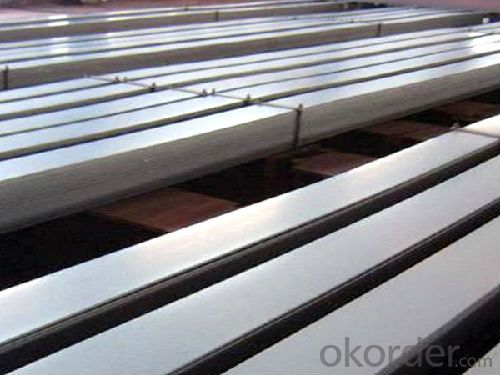
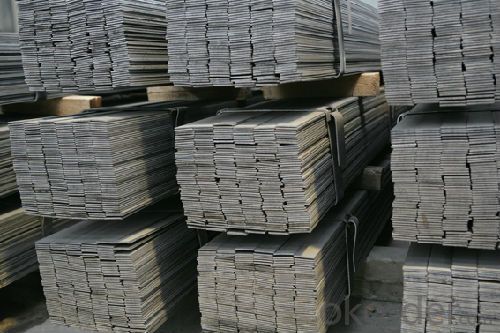
- Q: What is the difference between 60X6 and 50X4 flat steel in grounding?
- There are differences, mainly based on the local geological conditions, the purpose is to meet the requirements of grounding resistance.
- Q: Can steel flat bars be galvanized or coated with other materials?
- Yes, steel flat bars can be galvanized or coated with other materials.
- Q: Can steel flat bars be bent without cracking?
- Depending on their composition, thickness, and the bending process used, steel flat bars can be bent without cracking. Steel is highly malleable, meaning it can be bent or shaped without breaking. However, it's important to consider various factors that affect the extent to which steel bars can be bent without cracking. The flexibility and resistance to cracking of steel depend on its composition. Different grades of steel have different levels of ductility, with more ductile steels being better for bending without cracking. For example, mild steel is highly ductile and commonly used for bending operations without any issues. The thickness of the steel bar also plays a role. Thinner bars are more prone to cracking, especially if the bending radius is too small. It's important to ensure that the bending process matches the thickness of the steel bar to prevent cracking. The bending process itself is crucial in avoiding cracking. Steel flat bars can be bent using various techniques, such as cold bending or hot bending. Cold bending is done at room temperature by slowly applying force to the bar until it reaches the desired shape. Hot bending involves heating the steel bar to a specific temperature range before bending, which reduces the risk of cracking by increasing the material's ductility. To prevent cracking, it's important to apply gradual and even pressure during the bending process. Sharp or sudden bends can create stress concentrations, increasing the likelihood of cracking. It's recommended to use appropriate tools, such as bending machines or specialized dies, for a controlled and uniform bending process. In conclusion, steel flat bars can be bent without cracking if the steel composition is suitable, the thickness is appropriate, and the bending process is carefully executed. It's always advisable to consult experts or refer to specific guidelines and standards to ensure a successful and crack-free bending operation.
- Q: Are steel flat bars suitable for making agricultural equipment?
- Yes, steel flat bars are suitable for making agricultural equipment. Steel flat bars are known for their durability, strength, and versatility, making them an ideal material for various agricultural applications. They can be used to construct a wide range of equipment such as plows, cultivators, harrows, trailers, and livestock handling systems. Steel flat bars offer excellent structural integrity, allowing them to withstand the rigors of heavy-duty use in agricultural settings. Their high tensile strength makes them resistant to bending and breaking, ensuring long-lasting performance even under demanding conditions. Additionally, steel is highly resistant to corrosion, making it suitable for outdoor use and exposure to various weather conditions. Moreover, steel flat bars can easily be welded, cut, and shaped to meet specific design requirements, making them highly adaptable for manufacturing custom agricultural equipment. Their versatility allows for the creation of equipment that is tailored to the specific needs and preferences of farmers. In summary, steel flat bars are a reliable and suitable choice for making agricultural equipment due to their durability, strength, versatility, and resistance to corrosion.
- Q: What is the difference between steel band and steel ring? The steel strip is flat steel and the steel ring is made of steel. Am I right?
- A steel strip is a steel strip of relative range, and can be called a steel strip when the width is less than 1000.
- Q: Are steel flat bars suitable for making material handling systems or equipment?
- Indeed, steel flat bars present a highly suitable option for the fabrication of material handling systems or equipment. Renowned for their strength, durability, and versatility, steel flat bars prove to be an ideal choice for applications necessitating robust support and load-bearing capabilities. They offer the convenience of easy weldability, cutting, and the ability to be shaped into various dimensions and forms, thereby enabling customization to meet specific requirements. In the realm of material handling, systems and equipment frequently encounter substantial loads and endure frequent usage. In such demanding conditions, steel flat bars emerge as an outstanding choice. They exhibit remarkable resistance to impact, abrasion, and corrosion, ensuring long-lasting performance. Moreover, their rigid structure guarantees stability and reliability, effectively minimizing the likelihood of equipment failure or material handling mishaps. What's more, steel flat bars are conveniently available in multiple grades and finishes, including hot-rolled or cold-rolled options, thereby allowing for the selection of the most suitable material for the intended application. They prove to be invaluable in the construction of diverse components within material handling systems, such as frames, supports, guides, and brackets, providing a sturdy and dependable infrastructure. Overall, steel flat bars inherently possess the essential characteristics required to effectively manage materials in a wide range of industrial settings. Their strength, durability, versatility, and availability render them an exceptional choice when it comes to fabricating material handling systems or equipment.
- Q: Are steel flat bars suitable for fabrication of frames or structures?
- Yes, steel flat bars are commonly used in the fabrication of frames or structures due to their high strength, durability, and versatility. They provide excellent support and stability, making them suitable for various applications in construction, manufacturing, and engineering industries.
- Q: Can steel flat bars be used for architectural designs?
- Yes, steel flat bars can be used for architectural designs. They are versatile and can be used in various applications such as structural support, decorative elements, and framing. Steel flat bars offer strength, durability, and a sleek modern aesthetic, making them a popular choice in architectural design.
- Q: Can steel flat bars be used in agricultural applications?
- Steel flat bars are a versatile option for agricultural purposes. They possess a range of properties that make them well-suited for use in the agricultural industry. To begin with, steel flat bars are renowned for their strength and durability. They can withstand heavy loads and offer structural support, thereby making them ideal for agricultural equipment like trailers, plows, and cultivators. Moreover, steel flat bars exhibit resistance to corrosion, which is particularly important in agricultural settings where exposure to moisture, chemicals, and fertilizers is commonplace. This resistance ensures the longevity of the equipment and reduces maintenance expenses. Additionally, steel flat bars are highly malleable, enabling easy fabrication and customization. They can be bent, cut, or welded to meet specific requirements and design preferences. This adaptability renders them suitable for a variety of agricultural applications, including the construction of fences, gates, and animal enclosures. Overall, the strength, durability, corrosion resistance, and malleability of steel flat bars make them a dependable choice for agricultural applications. They provide the necessary support, endure harsh conditions, and can be effortlessly tailored to meet diverse agricultural needs.
- Q: Can steel flat bars be used for creating shelving or storage systems?
- Yes, steel flat bars can be used for creating shelving or storage systems. Steel flat bars are commonly used in construction and industrial applications due to their strength and durability. They can be easily welded or bolted together to create sturdy shelving structures, providing an efficient and reliable storage solution.
Send your message to us
Good Quality Special Steel Flat Bar For Automobile Used
- Loading Port:
- Shanghai
- Payment Terms:
- TT OR LC
- Min Order Qty:
- 50 m.t.
- Supply Capability:
- 1000 m.t./month
OKorder Service Pledge
OKorder Financial Service
Similar products
Hot products
Hot Searches
Related keywords
